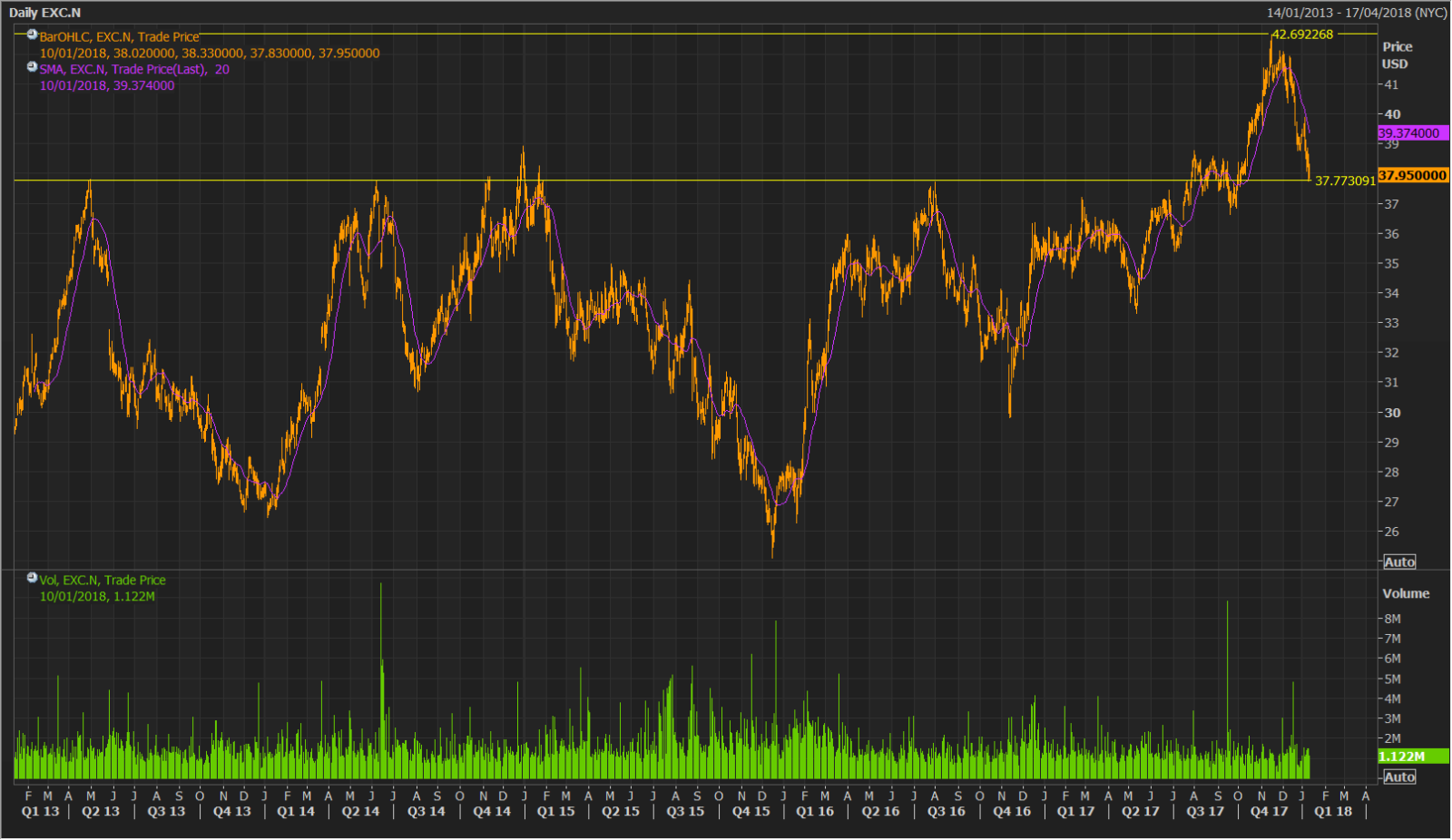Company Overview: Exelon Corporation is a utility services holding company. The Company, through its subsidiary, Exelon Generation Company, LLC (Generation), is engaged in the energy generation business. The Company, through its subsidiaries, Commonwealth Edison Company (ComEd), PECO Energy Company (PECO), Baltimore Gas and Electric Company (BGE), Pepco Holdings LLC (PHI), Potomac Electric Power Company (Pepco), Delmarva Power & Light Company (DPL) and Atlantic City Electric Company (ACE), is engaged in the energy delivery businesses. It operates through 12 segments: Generation's six segments: Mid-Atlantic, Midwest, New England, New York, ERCOT and Other Power Regions; ComEd; PECO; BGE, and PHI's three utility segments: Pepco, DPL and ACE. Generation's integrated business consists of the generation, physical delivery and marketing of power across geographical regions through its customer-facing business, Constellation, which sells electricity and natural gas to both wholesale and retail customers.
.png)
EXC Details
Earnings Expansion: Exelon Corporation (NYSE: EXC) has flagged that its utility Earnings per Share are expected to rise 6-8 percent annually from 2017 to 2020 with rate base growth of 6.5 percent offering a good earnings expansion. The free cash generation is strong enough to support utility growth and the group also targets to reduce debt by about $3 billion over the next 4 years. While recent issues pertaining to nuclear subsidies and its ZEC (Zero Emission Credit) program hover over the group, the case for ZECs is expected to be strong at the back of earlier District Court rulings dismissing complaints on jurisdictional standing and merits. Further, energy market reforms are expected to boost this Integrated utilities’ player in the coming period. The group seems to be tracking well on above-average growth plans.
Calvert Cliffs Nuclear Power Plant operated at 100 percent power: Exelon’s Calvert Cliffs Nuclear Power Plant has operated at 100 percent power, providing critical electricity to approximately two million homes during two of the highest daily peak demand periods ever recorded. This is done by the company when Winter Storm Grayson has pounded the East Coast with high winds and during this period, EXC’s five other nuclear facilities in the region also operated at approximately 100 percent power, as arctic temperatures gripped the Mid-Atlantic and Northeast. Winter Storm Grayson caused massive increase in the electricity demand. Moreover, all 14 EXC nuclear facilities are operating more than 90 percent of the time, even though the reactors are taken offline for refueling outages every 18 to 24 months. With the company having on?site fuel and 18?to 24?month operating cycles, EXC’s nuclear plants do not typically face fuel availability or delivery problems during the extreme weather.
Other Nuclear plants’ update: EXC’s nuclear facilities in New York, New Jersey, Maryland and Pennsylvania have reported near maximum levels of reliability for 11 million homes and businesses. All three facilities - Peach Bottom Atomic Power Station, Limerick Generating Station and Three Mile Island Unit 1 provided critical grid reliability during two of the highest daily peak demand periods ever recorded in the region. Further, EXC’s Upstate New York nuclear facilities, including R.E. Ginna, Nine Mile Point and FitzPatrick, have operated at 100 percent power, and provided critical electricity to more than three million homes and businesses during near-record levels of demand for power. Moreover, as per New York Independent System Operator (NYISO), the highest demand during the storm had touched 25,081 megawatts on January 5, approaching NYISO’s record winter peak demand of 25,738 megawatts, which was set on January 7, 2017. This can be well compared to EXC’s nuclear fleet operation at 95 percent capacity during the Polar Vortex of 2014. Additionally, EXC’s Oyster Creek Generating Station is providing critical electricity to regional customers, despite the record-breaking arctic weather. The operators at the station are closely monitoring a host of environmental conditions, and making power level adjustments to ensure the safety and minimizing the impact on aquatic life. The operators reduce the power as unusually low tides and high winds impact the water levels in the bay and subsequently, the plant’s intake canal. This measure is taken to ensure that operators have access to multiple and redundant sources of cooling water in the event of an emergent shutdown. Overall, the operators are adjusting power levels in response to environmental conditions.
.png)
Third Quarter EPS (Source: Company Reports)
Third Quarter 2017 Performance: EXC in the third quarter of FY17 delivered the adjusted (non?GAAP) operating earnings of $0.85 per share, which is at the mid?point of the company’s guidance range. The adjusted operating earnings reflect the impacts of lower load volumes delivered at Generation due to mild weather, lower realized energy prices related to Exelon’s ratable hedging strategy and unfavorable weather conditions at the utilities, partially offset by higher utility earnings due to regulatory rate increases, Zero Emissions Credit revenue related to the New York Clean Energy Standard (CES) and increased capacity prices. Additionally, in the third quarter of 2017, EXC has received New Jersey Board of Public Utilities (NJBPU) approval of ACE’s $43 million settlement for its electric distribution rate case. Maryland Public Service Commission (MDPSC) order was issued granting Pepco Maryland a $32 million increase for its electric distribution rate case. In addition, there was record third?quarter production for Exelon Nuclear and fewer refueling outage days compared to a year ago scenario. Furthermore, in the third quarter of 2017, ComEd’s adjusted operating earnings were $186 million, primarily due to the higher electric distribution and transmission formula rate earnings, offset by favorable weather conditions in 2016. In the 3Q 2017, PECO’s adjusted operating earnings were $114 million compared with $123 million in the third quarter of 2016, due to unfavorable weather conditions, partially offset by the impacts of higher income tax repairs deduction. BGE’s adjusted operating earnings were $64 million compared with $55 million in the third quarter of 2016 primarily due to regulatory rate increases. Generation’s adjusted operating earnings for the third quarter 2017 were $347 million compared with $376 million in the third quarter of 2016 due to the impacts of lower load volumes delivered due to mild weather and lower realized energy prices related to Exelon's ratable hedging strategy, partially offset by ZEC revenue related to the New York CES and increased capacity prices.
.png)
Narrowing Guidance Range (Source: Company Reports)
Outlook: EXC had narrowed the full?year 2017 guidance from $2.50 ?$2.80 to $2.55 ?$2.75 per share as the utilities performed better than planned, including the 9-cent impact from delays to the Illinois Zero Emission Credit (ZEC) contract signing from December 2017 to January 2018. The company continued to execute against a disciplined management plan that is focused on strengthening and optimizing the operations. EXC is now targeting another $250 million of annual cost savings by 2020, which will bring the total annual run?rate savings to over $700 million from initiatives identified since 2015.Additionally, EXC has plans to generate $6.8 billion of free cash flow at the Genco through 2020. EXC expects 135 terawatt hours of the generation output in PJM to benefit from price increase that were layer in over coming years at the existing hedges roll off. As per the group’s hedging activities, they ended the quarter over 11 percent to 14 percent behind their ratable hedging program in 2018 and 10 percent to 13 percent behind ratable in 2019 when considering cross-commodity hedges.
Improving ROE: The group reported a 22 percent improvement in reliability with PHI on track and delivered a 17 percent improvement in speed of restoration of outages. Such a performance shows the benefits going to their customers with the integration of PHI into Exelon. The group reported an improvement at PHI as per the trailing 12-month book ROEs, as compared to last quarter across all jurisdictions except ACE, where favorable weather in the third quarter of 2016 for the less beneficial summer weather this year was indicated. Overall, Exelon utilities ROEs are still nearly 10 percent, including PHI.
.png)
CapEx Spend (Source: Company Reports)
Projects’ developments: The group is developing two major projects worth mentioning. Their Pepco’s Waterfront Substation is part of the larger capital grid project which was expected to be finished last year. Post completion, their project would enhance the reliability to current customers while supporting the plan in the Capitol Riverfront and Southwest Waterfront areas in the next 20 to 30 years. ComEd’s Grand Prairie Gateway transmission line is a $200 million, 60- mile-long transmission line in Northern Illinois that offers structural benefits to the market, leading to a lower energy and congestion charges to customers and a better import capability of over 1,000 megawatts. It has been indicated that over the next 15 years, customers will be able to save over $120 million while carbon emissions would be cut by nearly 500,000 tons.
Stock performance: EXC stock has moved up over 8.2 percent in the last one year (as of January 10, 2018) with the last one month a little tough owing to volatile environment and delays with regards to ZEC contract, but we believe that the long-term potential stays resilient based on the progress seen in 2017. We give a “Buy” recommendation on the dividend paying stock at the current price of $37.95, ahead of its fourth quarter of 2017 earnings result which would be released on February 7, 2018.

EXC Daily Chart (Source: Thomson Reuters)
Disclaimer
is general information only and it does not take into account your investment objectives, financial situation or needs. You should therefore consider whether the advice is appropriate to your investment objectives, financial situation and needs before acting upon it. You should seek advice from a financial adviser, stockbroker or other professional (including taxation and legal advice) as necessary before acting on any advice. Not all investments are appropriate for all people. Kalkine.com.au and associated pages are published by Kalkine Pty Ltd ABN 34 154 808 312 (Australian Financial Services License Number 425376). The information on this website has been prepared from a wide variety of sources, which Kalkine Pty Ltd, to the best of its knowledge and belief, considers accurate. You should make your own enquiries about any investments and we strongly suggest you seek advice before acting upon any recommendation. Kalkine Pty Ltd has made every effort to ensure the reliability of information contained in its newsletters and websites. All information represents our views at the date of publication and may change without notice. To the extent permitted by law, Kalkine Pty Ltd excludes all liability for any loss or damage arising from the use of this website and any information published (including any indirect or consequential loss, any data loss or data corruption). If the law prohibits this exclusion, Kalkine Pty Ltd hereby limits its liability, to the extent permitted by law to the resupply of services. There may be a product disclosure statement or other offer document for the securities and financial products we write about in Kalkine Reports. You should obtain a copy of the product disclosure statement or offer document before making any decision about whether to acquire the security or product. The link to our Terms & Conditions has been provided please go through them and also have a read of the Financial Services Guide. On the date of publishing this report (mentioned on the website), employees and/or associates of Kalkine Pty Ltd do not hold positions in any of the stocks covered on the website. These stocks can change any time and readers of the reports should not consider these stocks as advice or recommendations.
AU

.png)
.png)
.png)
.png)

 Please wait processing your request...
Please wait processing your request...